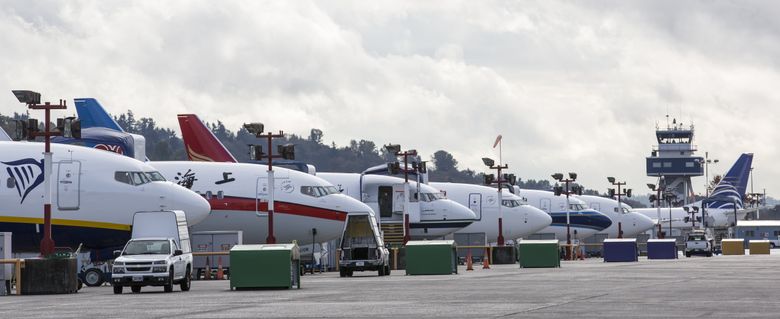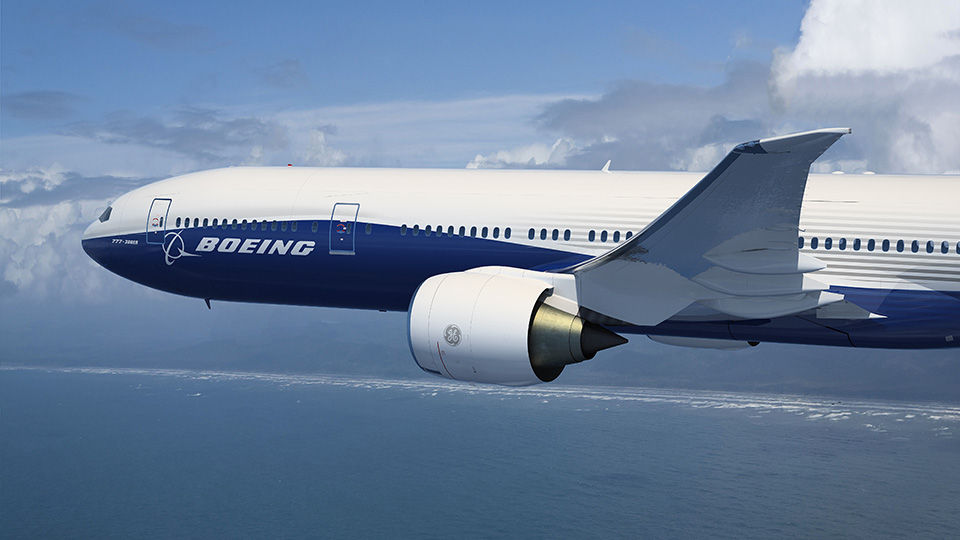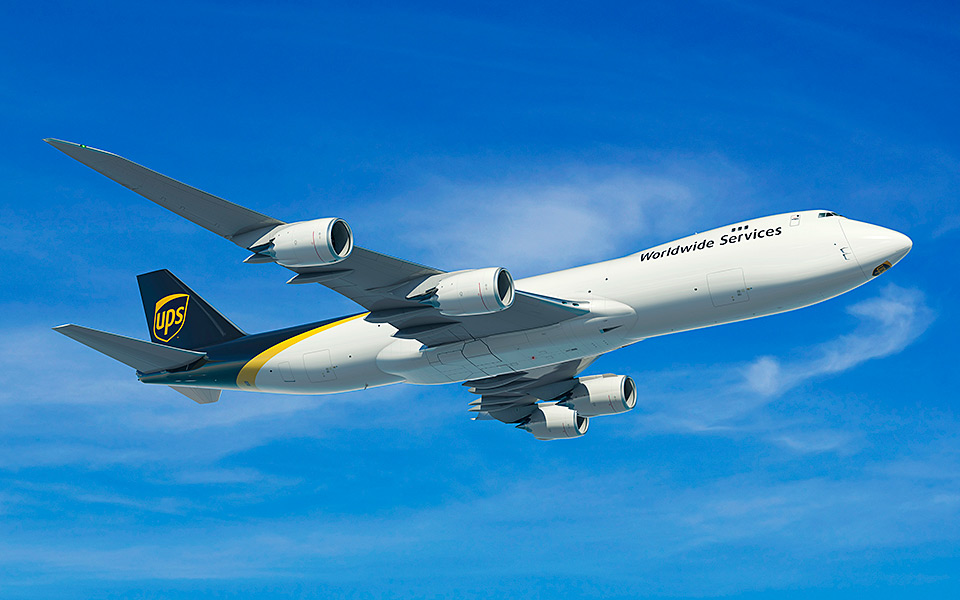Leeham News and Analysis
There's more to real news than a news release.
Airbus, Boeing deferrals may indicate slowing global economy
Subscription Required
Introduction

Boeing 737 flightline at Boeing Field: 737s awaiting delivery. Seattle Times photo via Google images.
Nov. 17, 2016, © Leeham Co.: The deferral by United Airlines of 65 Boeing 737-700s announced Tuesday caused some observers to conclude this has a negative impact on the manufacturer, but this may well overlook a larger issue.
UAL is the latest “quality” airline to announce deferrals to reschedule capital expenditures or because of not needing the aircraft now.
Softening yields, particularly among US airlines, indicate over-capacity despite load factors of 85% or more, say industry observers.
While the backlogs of Boeing and Airbus remain solid today, do the actions of several major airlines indicate the leading edge of a global economy that’s beginning to soften?
Summary
Boeing stock sell-off on United news appears misplaced
Nov. 16, 2016, © Leeham Co.: The market sell off yesterday of Boeing stock appeared on the surface to be a reaction to the news that United Airlines is deferring 61 737-700s and switching these to four larger 737-800s and the balance to either the 737-8 or 737-9.

Figure 1. Boeing stock traded down on news that United Airlines is deferring 65 737s. The price stayed flat through early today. But stock for Spirit Aerosystems, which makes the 737 fuselages, recovered after a short dip (Figure 2). This suggests the Boeing sell-off was for other reasons. Click on image to enlarge.
Boeing’s stock today remains flat-to-down slightly.
An odd thing happened concurrent to Boeing’s stock decline.
After a short dip, stock of Spirit Aerosystems recovered to the level before the UAL news and remained there through the time of this writing. Spirit makes the 737 fuselages. If Boeing’s stock was hit by the United decision, then logic suggests Spirit’s stock should have been, too.
This suggests the Boeing’s sell off has other reasons.
Pontifications: Leahy’s retirement from Airbus
Nov. 14, 2016, © Leeham Co.: News emerged last week that Airbus super-salesman John Leahy has a new deputy, Kiran Rao.
A new title for Rao wasn’t revealed in the Bloomberg story. He currently is EVP-Strategy and Marketing, so he already was right up there behind Leahy.
But the report, which is presumed true (Bloomberg has a good track record on this sort of thing) is pretty clear indication that the 66-year old Leahy is soon to retire and Rao is almost certainly his successor.
Leahy is Chief Operating Officer-Customers for Airbus Commercial.
Boeing sees wide-body market recovery from 2020
Subscription Required
Introduction
Nov. 3, 2016, © Leeham Co.: Boeing may have solved its pressing problem of largely filling the production gap for the 747-8, but there is still a long way to go for the

Boeing 777X. Boeing’s view of the wide-body market has shifted. Once it thought a strong market through 2020. Now it sees recovery in demand from 2020. Boeing photo via Google images.
777.
Boeing Co. CEO Dennis Muilenburg said last week the production rate for the 777 Classic may need to come down another 1-2 per month from the previously announced 5.5/mo if sales don’t pick up.
Despite a pending order for 15 from Iran Air and the perpetual sales campaigns, Muilenburg otherwise painted a picture about wide-body demand that is anything but rosy.
Summary
- Boeing no longer sees strong demand for wide-bodies through this decade. Recovery won’t resume until the start of the next decade.
- Thus, successfully bridging the 777 Classic to the 777X becomes more challenging.
- Investors yawn at more potential 777 production rate cuts.
UPS order tops off 747-8 line through 2020

UPS Boeing 747-8F. Source: Boeing.
Subscription Required
Introduction
Oct. 31, 2016, © Leeham Co.: Last week’s order for 14 Boeing 747-8Fs and 14 options by UPS assures continuation of the program through 2020.
If options are exercised, and if previously announced deals with other customers finally are consummated, the program should continue at least well into the 2020 decade.
Summary
- UPS (but not Boeing) revealed the delivery timeline for the order.
- The mysterious Volga-Dnepr/AirBridgeCargo that was announced at the Paris and Farnborough air shows for up to 20 747-8Fs still hasn’t been firmed up. Only four are listed on the Boeing website this year.
- Iran Air will order four 747-8s under the reported terms of the agreement with Boeing. The US government blessed the deal recently.
- The first of three 747-8s for the presidential fleet is now scheduled for delivery in October 2017, it’s believed.
Pontifications: Hawaiian Air ponders A380
Oct. 31, 2016, © Leeham Co.: Hawaiian Airlines continues to ponder the possibility of acquiring one or two Airbus A380s, its CEO said on the third quarter earnings call—something that raises eyebrows and a lot of questions with industry officials.
Mark Dunkerley, responding to a question on the call, said there are two or three routes that could support the giant A380.
Bjorn’s Corner: Turbofan engine challenges, Part 1
October 28, 2016, ©. Leeham Co: Before we go into the details on the innards of airliner turbofans, we will look at some basics. We do that so that everyone is on the same page.
A turbofan engine generates thrust by pumping air out the back of the engine. This air has a higher speed than surrounding air. Air is actually quite heavy: it weighs 1.2kg per m3 at sea level. By kicking out air at an overspeed in relation to the aircraft, thrust is generated.
In a modern turbofan, the kicking gets done by the fan to 80-90% in the modern By Pass Ratio (BPR) 8-10 engines. A single aisle engine generating 10 tonnes of thrust throws around 350kg of air per second backwards at close to sound speed in a take-off situation. To drive the fan to do that, there is a lot of shaft horse-power needed, around 30,000hp.

Figure 1. Work cycle for jet engine/turbofan core compared to car engine. Source: Rolls-Royce book “The Jet Engine.”
These hp are generated by the core. The thermodynamic cycle to generate all these hp in a jet engine or turbofan core (we call both a gas turbine) is like the one in a normal car engine, Figure 1, with the difference that it is a continuous cycle.
We will now go through this cycle in steps. Read more
Counting down to 737-10, NMA
Subscription Required
Introduction
Oct. 27, 2016, © Leeham Co.: Boeing faces decisions in the near term on whether to proceed with the 737-10 stretch of the MAX 9 and the New Mid-range Airplane (NMA) to serve the Middle of the Market sector (MOM).
The 737-10 is intended to compete with the Airbus A321neo, stemming significant bleed at the top end of the 737 line.
The NMA will address the top end of the MOM sector, carry more passengers and have more range than the Boeing 757 and A321neoLR.
Boeing still has critical issues facing it before proceeding with either airplane.
Summary
- A simple stretch to create the 737-10 has technical and operational issues.
- The proposed date for entry-into-service still gives Airbus an insurmountable lead.
- The market for the 737-10 remains limited. Is the return on investment there?
- The market for the NMA is identified in the abstract—but price will be a key driver.



